Capital One 2012 Annual Report Download - page 303
Download and view the complete annual report
Please find page 303 of the 2012 Capital One annual report below. You can navigate through the pages in the report by either clicking on the pages listed below, or by using the keyword search tool below to find specific information within the annual report.-
 1
1 -
 2
2 -
 3
3 -
 4
4 -
 5
5 -
 6
6 -
 7
7 -
 8
8 -
 9
9 -
 10
10 -
 11
11 -
 12
12 -
 13
13 -
 14
14 -
 15
15 -
 16
16 -
 17
17 -
 18
18 -
 19
19 -
 20
20 -
 21
21 -
 22
22 -
 23
23 -
 24
24 -
 25
25 -
 26
26 -
 27
27 -
 28
28 -
 29
29 -
 30
30 -
 31
31 -
 32
32 -
 33
33 -
 34
34 -
 35
35 -
 36
36 -
 37
37 -
 38
38 -
 39
39 -
 40
40 -
 41
41 -
 42
42 -
 43
43 -
 44
44 -
 45
45 -
 46
46 -
 47
47 -
 48
48 -
 49
49 -
 50
50 -
 51
51 -
 52
52 -
 53
53 -
 54
54 -
 55
55 -
 56
56 -
 57
57 -
 58
58 -
 59
59 -
 60
60 -
 61
61 -
 62
62 -
 63
63 -
 64
64 -
 65
65 -
 66
66 -
 67
67 -
 68
68 -
 69
69 -
 70
70 -
 71
71 -
 72
72 -
 73
73 -
 74
74 -
 75
75 -
 76
76 -
 77
77 -
 78
78 -
 79
79 -
 80
80 -
 81
81 -
 82
82 -
 83
83 -
 84
84 -
 85
85 -
 86
86 -
 87
87 -
 88
88 -
 89
89 -
 90
90 -
 91
91 -
 92
92 -
 93
93 -
 94
94 -
 95
95 -
 96
96 -
 97
97 -
 98
98 -
 99
99 -
 100
100 -
 101
101 -
 102
102 -
 103
103 -
 104
104 -
 105
105 -
 106
106 -
 107
107 -
 108
108 -
 109
109 -
 110
110 -
 111
111 -
 112
112 -
 113
113 -
 114
114 -
 115
115 -
 116
116 -
 117
117 -
 118
118 -
 119
119 -
 120
120 -
 121
121 -
 122
122 -
 123
123 -
 124
124 -
 125
125 -
 126
126 -
 127
127 -
 128
128 -
 129
129 -
 130
130 -
 131
131 -
 132
132 -
 133
133 -
 134
134 -
 135
135 -
 136
136 -
 137
137 -
 138
138 -
 139
139 -
 140
140 -
 141
141 -
 142
142 -
 143
143 -
 144
144 -
 145
145 -
 146
146 -
 147
147 -
 148
148 -
 149
149 -
 150
150 -
 151
151 -
 152
152 -
 153
153 -
 154
154 -
 155
155 -
 156
156 -
 157
157 -
 158
158 -
 159
159 -
 160
160 -
 161
161 -
 162
162 -
 163
163 -
 164
164 -
 165
165 -
 166
166 -
 167
167 -
 168
168 -
 169
169 -
 170
170 -
 171
171 -
 172
172 -
 173
173 -
 174
174 -
 175
175 -
 176
176 -
 177
177 -
 178
178 -
 179
179 -
 180
180 -
 181
181 -
 182
182 -
 183
183 -
 184
184 -
 185
185 -
 186
186 -
 187
187 -
 188
188 -
 189
189 -
 190
190 -
 191
191 -
 192
192 -
 193
193 -
 194
194 -
 195
195 -
 196
196 -
 197
197 -
 198
198 -
 199
199 -
 200
200 -
 201
201 -
 202
202 -
 203
203 -
 204
204 -
 205
205 -
 206
206 -
 207
207 -
 208
208 -
 209
209 -
 210
210 -
 211
211 -
 212
212 -
 213
213 -
 214
214 -
 215
215 -
 216
216 -
 217
217 -
 218
218 -
 219
219 -
 220
220 -
 221
221 -
 222
222 -
 223
223 -
 224
224 -
 225
225 -
 226
226 -
 227
227 -
 228
228 -
 229
229 -
 230
230 -
 231
231 -
 232
232 -
 233
233 -
 234
234 -
 235
235 -
 236
236 -
 237
237 -
 238
238 -
 239
239 -
 240
240 -
 241
241 -
 242
242 -
 243
243 -
 244
244 -
 245
245 -
 246
246 -
 247
247 -
 248
248 -
 249
249 -
 250
250 -
 251
251 -
 252
252 -
 253
253 -
 254
254 -
 255
255 -
 256
256 -
 257
257 -
 258
258 -
 259
259 -
 260
260 -
 261
261 -
 262
262 -
 263
263 -
 264
264 -
 265
265 -
 266
266 -
 267
267 -
 268
268 -
 269
269 -
 270
270 -
 271
271 -
 272
272 -
 273
273 -
 274
274 -
 275
275 -
 276
276 -
 277
277 -
 278
278 -
 279
279 -
 280
280 -
 281
281 -
 282
282 -
 283
283 -
 284
284 -
 285
285 -
 286
286 -
 287
287 -
 288
288 -
 289
289 -
 290
290 -
 291
291 -
 292
292 -
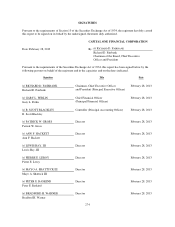 293
293 -
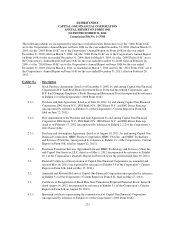 294
294 -
 295
295 -
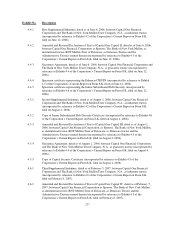 296
296 -
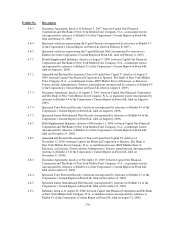 297
297 -
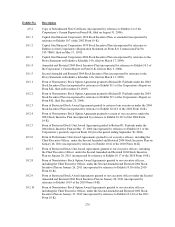 298
298 -
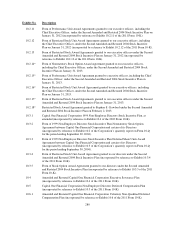 299
299 -
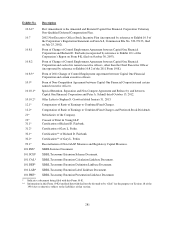 300
300 -
 301
301 -
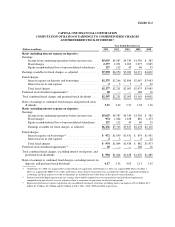 302
302 -
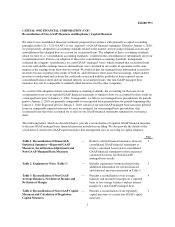 303
303 -
 304
304 -
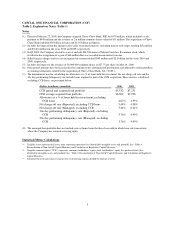 305
305 -
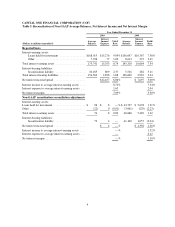 306
306 -
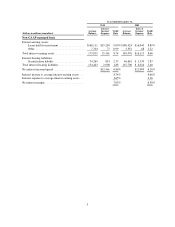 307
307 -
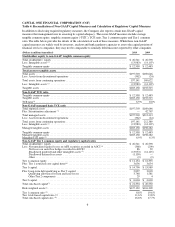 308
308 -
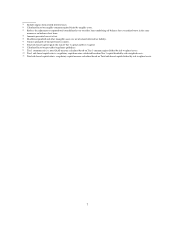 309
309 -
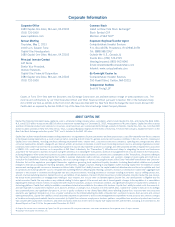 310
310 -
 311
311
 |
 |

Exhibit 99.1
CAPITAL ONE FINANCIAL CORPORATION (COF)
Reconciliation of Non-GAAP Measures and Regulatory Capital Measures
We refer to our consolidated financial statements prepared in accordance with generally accepted accounting
principles in the U.S. (“U.S. GAAP”) as our “reported” or GAAP financial statements. Effective January 1, 2010,
we prospectively adopted two accounting standards related to the transfer and servicing of financial assets and
consolidations that changed how we account for securitized loans. The adoption of these accounting standards,
which we refer to as “consolidation accounting standards,” resulted in the consolidation of substantially all of our
securitization trusts. Prior to our adoption of these new consolidation accounting standards, management
evaluated the company’s performance on a non-GAAP “managed” basis, which assumed that securitized loans
were not sold and the earnings from securitized loans were classified in our results of operations in the same
manner as the earnings from loans that we owned. We believed that our managed basis information is useful to
investors because it portrays the results of both on- and off-balance sheet loans that we manage, which enables
investors to understand and evaluate the credit risks associated with the portfolio of loans reported on our
consolidated balance sheet and our retained interests in securitized loans. Our non-GAAP managed basis
measures may not be comparable to similarly titled measures used by other companies.
As a result of the adoption of these consolidation accounting standards, the accounting for the loans in our
securitization trusts in our reported GAAP financial statements is similar to how we accounted for these loans on
a managed basis prior to January 1, 2010. Consequently, we believe our managed basis presentations for periods
prior to January 1, 2010 are generally comparable to our reported basis presentations for periods beginning after
January 1, 2010. In periods prior to January 1, 2010, certain of our non-GAAP managed basis measures differed
from our comparable reported measures because we assumed, for our managed basis presentation, that
securitized loans that were accounted for as sales in our GAAP financial statements remained on our balance
sheet.
The following tables, which are described below, provide a reconciliation of reported GAAP financial measures
to the non-GAAP managed basis financial measures included in our filing. We also provide the details of the
calculation of certain non-GAAP capital measures that management uses in assessing its capital adequacy.
Page
Table 1: Reconciliation of Financial &
Statistical Summary—Reported GAAP
Measures, Securitization Adjustments and
Non-GAAP Managed Basis Measures
— Reflects selected financial measures from our
consolidated GAAP financial statements or
metrics calculated based on our consolidated
GAAP financial statements to those measures
calculated based on our Non-GAAAP
managed basis results.
2
Table 2: Explanatory Notes (Table 1) — Includes explanatory footnotes that provide
additional information for certain financial
and statistical measures presented in Table 1.
3
Table 3: Reconciliation of Non-GAAP
Average Balances, Net Interest Income and
Net Interest Margin
— Presents a reconciliation of our average
balances and net interest margin on a reported
basis to our average balances and net interest
margin on a non-GAAP managed basis.
4
Table 4: Reconciliation of Non-GAAP Capital
Measures and Calculation of Regulatory
Capital Measures
— Presents a reconciliation of our regulatory
capital measures to certain non-GAAP capital
measures.
5
1
